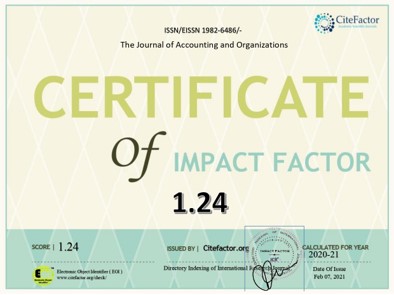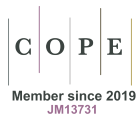Accounting Recognition in Native Forest Operations: The Agrocortex Case
DOI:
https://doi.org/10.11606/issn.1982-6486.rco.2019.162327Keywords:
Biological assets, Accounting recognition, Accounting theory, Native forest, Sustainable forest managementAbstract
The aim of this paper was to analyze and propose a solution for accounting recognition of native forest operations based on the Agrocortex case. Agrocortex operates a native forest in the Amazon region and its operation is outside the scope of accounting standards and its financial statements have been prepared without recognition of native forests. In view of this, a solution proposal was built, based on IAS 8 - Accounting Policies, Changes in Accounting Estimates and Errors, with two aspects: (1) elaboration of an accounting policy to proceed with the accounting recognition of operations in native forests of similar to planted forests, in accordance with IAS 41, with fair value measurement; and (2) elaboration of an accounting recognition for native forest operations through sustainable forest management in the financial statements. The second aspect is a suggestion to the regulators and entities of the accounting class, to analyze, based on the case shown, the theoretical aspects of accounting recognition in native forest operations, through sustainable forest management.
Downloads
References
XXIII Congresso Brasileiro de Custos.
Aryanto, Y. H. (2011). Theoretical Failure of IAS 41. Recuperado de https://ssrn.com/abstract=1808413
Balieiro, M. R., Espada, A. L. V., Nogueira, O., Palmieri, R., & Lentini, M. (2010). As Concessões de Florestas
Públicas na Amazônia Brasileira: Um manual para pequenos e médios produtores florestais. Piracicaba:
Imaflora, SP; Belém: IFT, PA.
Confederação Nacional da Indústria [CNI]. (2016). Florestas e indústria: agenda de desenvolvimento. Brasília:
CNI.
Comitê de Pronunciamentos Contábeis [CPC]. (2009). Pronunciamento Técnico n. 23 Políticas Contábeis, Mudança de Estimativa e Retificação de Erro. Recuperado de: http://static.cpc.mediagroup.com.br/Documentos/296_CPC_23_rev%2003.pdf
Comitê de Pronunciamentos Contábeis [CPC]. (2009). Pronunciamento Técnico n. 29 Ativo Biológico e Produto Agrícola. Recuperado dehttp://static.cpc.mediagroup.com.br/Documentos/324_CPC_29_rev%2008.pdf.
Comitê de Pronunciamentos Contábeis [CPC]. (2011). Pronunciamento Conceitual Básico (R1). Recuperado de http://www.cpc.org.br/CPC/Documentos-Emitidos/Pronunciamentos/Pronunciamento?Id=80.
Feleagã, L., Feleagã, N., & Raileanu, V. (2012). Theoretical considerations about implementation of IAS 41 in
Romania. Theoretical and Applied Economics 19(2), 31-38.
Fischer, M., & Marsh, T. (2013). Biological Assets: Financial Recognition and Reporting Using US and International
Accounting Guidance. Journal of Accounting and Finance 2(13), 57 – 74.
Fujihara, M.A., Cavalcanti, R., Guimarães, A., & Garlipp, R. (2009). O valor das florestas. São Paulo: Terra das
Artes Editora.
Grege-Stalmane, E. (2010). Challenges in accounting the forests - a Latvian case study. Annals of Forest Research
1(53), 53 – 58.
Hendriksen, E. S., & Van Breda, M. F. (1999). Teoria da Contabilidade. 5a edição. São Paulo: Atlas.
Herbohn, K., & Herbohn, J. (2006). International Accounting Standard (IAS) 41: What Are the Implications for
Reporting Forest Assets? Small-scale Forest Economics, Management and Policy, 5(2), 175 – 189. DOI:
https://doi.org/10.1007/s11842-006-0009-1.
Peterson, R., & Herbohn, J. L. (1998). Accounting for forestry assets: Current practice and future
directions. Australian Accounting Review, 8(15), 54-66. DOI: https://doi.org/10.1111/j.1835-2561.1998.
tb00080.x.
Hogg, J. N., & Jöbstl, H. A. (2008). Developments in forestry business accounting and reporting: an international
study. Austrian Journal of Forest Science. 125 (4), 219–250.
Instituto Floresta Tropical [IFT]. (2014) Manejo florestal e exploração de impacto reduzido em florestas
naturais de produção da Amazônia. Informativo técnico n. 1. Recuperado de: http://ift.org.br/wp-content/
uploads/2014/11/Informativo-T%C3%A9cnico-1.pdf.
Lima, J. P. C., Antunes, M. T. P., de Mendonça Neto, O. R., & Peleias, I. R. (2012). Estudos de caso e sua aplicação:
proposta de um esquema teórico para pesquisas no campo da contabilidade. Revista de Contabilidade e
Organizações, 6(14), 127-144. DOI: https://doi.org/10.11606/rco.v6i14.45403.
Martins, E., Gelbcke, E. R., Santos, A. D., & Iudícibus, S. D. (2013). Manual de contabilidade societária: aplicável
a todas as sociedades: de acordo com as normas internacionais e do CPC.
Rech, I. J., & Pereira, I. V. (2012). Fair value: analysis of measurement methods applicable for fixed biological
assets. Custos e @gronegócio on line. 8(2), 131-157.
Serviço Florestal Brasileiro. (2013). Florestas do Brasil em resumo - 2013: dados de 2007-2012. Brasília: SFB. Disponível em http://www.florestal.gov.br/publicacoes/tecnico-cientifico/florestas-do-brasil-em-
resumo-2013
Yin, R. K. (2005). Estudo de caso: planejamento e métodos. 3. ed. Porto Alegre: Bookman.
Downloads
Published
Issue
Section
License
The RCO adopts the Free Open Access policy, under the standard Creative Commons agreement (CC BY-NC-ND 4.0). The agreement provides that:
- Submission of text authorizes its publication and implies commitment that the same material is not being submitted to another journal. The original is considered definitive.
- Authors retain the copyright and grant the journal the right of first publication, with the work simultaneously licensed under the Creative Commons Attribution License which allows the sharing of the work with acknowledgment of authorship and initial publication in this journal.
- Authors are authorized to take additional contracts separately, for non-exclusive distribution of the version of the work published in this journal (e.g. publish in an institutional repository or as a book chapter), with necessary recognition of authorship and initial publication in this journal.
- Authors are allowed and encouraged to publish and distribute their work online (e.g. in institutional repositories or on their personal page) before or during the editorial process, as this can generate productive changes as well as increase the impact and citation of published work (See The Effect of Free Access).
- The journal does not pay copyright to the authors of the published texts.
- The journal's copyright holder, except those already agreed in the Free Open Access Agreement (CC BY-NC-ND 4.0), is the Accounting Department of the Faculty of Economics, Administration and Accounting of Ribeirão Preto of the University of São Paulo.
No submission or publication fees are charged.
Up to 4 authors per article are accepted. Exceptionally duly justified cases may be reviewed by the Executive Committee of the RCO. Exceptional cases are considered as: multi-institutional projects; manuscripts resulting from the collaboration of research groups; or involving large teams for evidence collection, construction of primary data, and comparative experiments.
It is recommended that the authorship be ordered by contribution of each of the individuals listed as authors, especially in the design and planning of the research project, in obtaining or analyzing and interpreting data, and writing. Authors must declare the actual contributions of each author, filling the letter to the editor, at the beginning of the submission, taking responsibility for the information given.
Authors are allowed to change throughout the evaluation process and prior to the publication of the manuscript. The Authors should indicate the composition and final order of authorship in the document signed by all those involved when accepted for publication. If the composition and authoring order is different than previously reported in the system, all previously listed authors should be in agreement.
In the case of identification of authorship without merit or contribution (ghost, guest or gift authorship), the RCO follows the procedure recommended by COPE.







